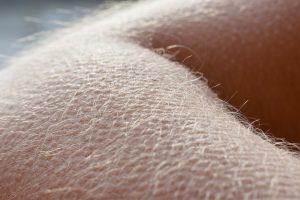*Extremes of Temperature
A healthy adult body functions best at an internal temperature of around 37°C (98.6°F) but everyone has their own individual "normal" body temperature, which may be slightly higher or lower.
A normal temperature in babies and children is about 36.4oC, but again this can vary slightly from child to child and can change naturally throughout the day.
Our internal body temperature is regulated by a part of our brain called the hypothalamus.
Low Temperature

If our temperature is too low, the hypothalamus makes sure that the body generates and maintains heat. We do this by shivering.
When we shiver, we create heat through muscle movement. Tiny muscles also make the hairs on the skin stand up, to trap warm air (goose pimples).
High Temperature

If our body temperature is too high, the hypothalamus makes sure that the body gets rid of excess heat. We do this by sweating.
Sweat glands release sweat to decrease the temperature. Sweat leaves our skin through pores and evaporates when it hits outside air. As the sweat evaporates off the body, we cool down.
A high temperature (fever) is 38°C (100.4°F) or higher
Many things can cause a high temperature, but it's usually caused by your body fighting an infection.
The regulation of body temperature doesn't always work perfectly in babies and younger children. Compared to older children and adults, they also sweat less when it is warm, and it takes longer for them to start sweating. As a result of this, they are more likely to react with a fever.
